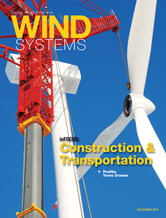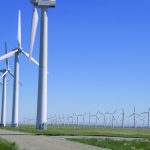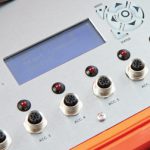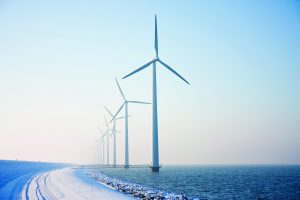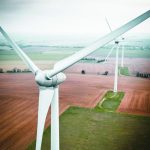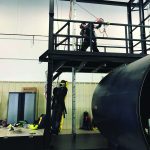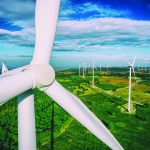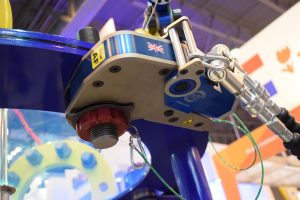Wind energy continues to be a robust industry with wind-farm construction predicted well into 2020. The U.S. Department of Energy’s Wind Vision Report states the U.S. may be able to meet 10 percent of its electricity needs through wind power by 2020 and predicts meeting 20 percent by 2030 and 35 percent by 2050.
Since turbines cannot be erected or maintained without cranes, the numbers coming from the wind industry bode well for companies that offer crane and heavy-haul services. Construction companies with in-house fleets are well-positioned to handle current market needs, but the predicted growth will require planning.
Wanzek Construction, Inc., a heavy industrial contractor specializing in wind-energy construction and O&M services, sees its in-house fleet that includes 40 cranes as a key business asset. Looking beyond 2016, Bryce Peterson, vice president of Construction over Wanzek’s crane services division, is developing an approach that will lay the foundation for a quick-response crane supply program.
Sustainable Growth
“Wanzek has implemented an advancement plan structured to allow for sustainable growth,” Peterson said. “The crane services division is applying the same plan on a micro level to our department.”
The program includes a focus on communication and planning, including a newly rolled out Mobile Vision Program (MVP), specialized training, a lean Kaizen approach to quality, and a continued commitment to safety.
Since crane equipment is essential to wind projects throughout the life of a wind farm, including maintenance and end-of-life, access to cranes may become a critical issue to wind-farm owners and operators for both construction and operations and maintenance.
Wanzek has established relationships with crane suppliers as well as large rental vendors. Part of that planning is balancing owned assets and rental assets to keep ahead of supply. The company has entered into several long-term lease agreements to ensure clients’ future needs for both construction and maintenance are met.

Crane Services Vital
Jake Nikle, division manager of Wanzek’s O&M Services, said crane services are vital to all phases of a wind project.
“From the day the turbine is erected, to the time it is ready to be taken down, cranes are a necessary tool for building and maintaining wind farms,” he said. “Following construction, most sites will have the need for 350-600t cranes a couple times per year to replace major components such as gearboxes, main bearings, generators, and blades. Advances in technology have improved turbine component design in recent years, which may make it more cost effective for cranes to replace certain components site-wide, extending the life of a site by 10 years or more. And when a PPA comes to an end or the turbines no longer operate efficiently, the wind project may need to be decommissioned. The safest way to remove the turbines is using cranes in a reverse of the construction phase of the project.”
Mobile Technology Initiative
Wanzek’s mobile technology initiative, MVP, is part of its communication plan. It expands the use of mobile devices in the field and establishes daily integration of information with the company’s back-end systems. This allows field and corporate management teams access to real-time information. These “smart job sites” have proven critical to establishing an uninterrupted communication channel.
MVP gives crews access to reports, inspections, and manuals at their fingertips. It also allows teams to determine — in real time — any potential maintenance issues that could lead to downtime, plan scheduled maintenance items such as oil changes, and quickly verify equipment maintenance status between projects to ensure machines are always in prime condition for the customer.
Peterson sites communication as a major factor in successful turbine maintenance.
“Mobilization is one of the main costs associated with large crane usage on-site,” he said. “If you are working with owners to forecast possible future repairs, you have the ability to reduce the number of times a crane needs to be mobilized to the site by handling multiple projects on the same trip, reducing the costs dramatically.”
Nikle agreed.
“We aim to minimize the total time our cranes are on site, which helps keep our customers’ costs down,” Nikle said. “Communication between the client and our team is essential. The more information we have about upcoming crane needs, the better we can schedule sequential projects in the area and reduce overall costs to the clients.”
Advancements in wind technology have led to an increase in turbine sizes. According to The American Society of Mechanical Engineers (ASME), rotors have increased in size from about 150 feet in diameter to 400 feet in diameter with towers more than 300 feet high. These size increases allow turbines to extract more power from the wind.

Using Largest Cranes
The increase in size also means turbine erection requires some of the largest cranes in use today. Crews are lifting components in excess of 90 tons to 300-plus feet. Wanzek’s safety and training includes hazard analysis, crane assembly/disassembly, inspection, wind/weather consideration, travel paths/limits, control of lift area, and lift planning. Wanzek’s O&M Services team also has personnel certified to Global Wind Organization (GWO) standards for tower rescue, fire prevention, material handling, and emergency response.
In order to retain high quality standards during peak market demand, Wanzek’s crane services team plans to implement the company’s lean Kaizen approach. This method focuses on incremental changes in processes to improve efficiency and quality. Since most wind-farm sites are remote, the team has performed a lean quality initiative on crane set-up and tear-down in order to reduce time spent during mobilization and transport from site to site.
“Lean quality initiatives have been a great asset to Wanzek’s crane services,” Nikle said. “Our teams have used a variety of tactics from 5S for organizing tools and rigging to spaghetti diagrams and value-stream mapping to improve jobsite layouts and crane assembly times.”
In addition to using a lean approach, the company highlights best practices.
“All of our operators and riggers are certified and knowledgeable of the equipment they work with and around,” Nikle said. “Proper maintenance is key to keeping equipment in top operating condition. It’s essential that cranes are operated within their rated capabilities and manufacturer specifications. Wanzek crane and rigging engineers design our lifts using additional factors of safety to ensure safe operation.”
Good Sign
The extension of the wind energy Production Tax Credit (PTC) and Investment Tax Credit (ITC) is a good sign that construction will continue on wind-energy projects. The Environmental and Energy Study Institute (EESI) suggests the extension could result in the installation of almost twice as much wind capacity in the U.S. as would otherwise have been the case between 2016 and 2020.
According to the EESI, more businesses are securing their own clean energy sources. Business procurement of clean energy doubled in 2014 and again in 2015, reaching 3.5 GW. Wind energy has attracted the most corporate investment.
With wind project construction booming and end-of-life efforts beginning for first generation wind-farm equipment, crane and heavy-haul transport will continue to be a significant aspect in the success of wind-energy growth. Equipped with an extensive in-house fleet, long-term, second-party leases, and a multi-tiered growth plan, Wanzek is positioned to meet the expected high demand for efficient crane services for the wind industry.
















